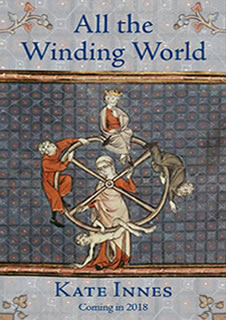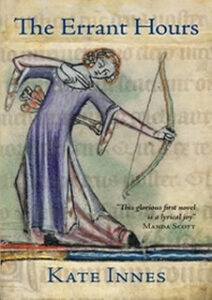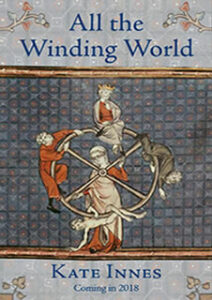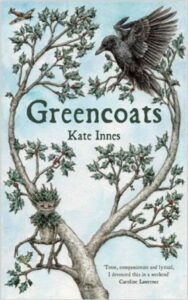
JANE BURN – POETRY AS HARD GRAFT, INSPIRATION, REACTION OR EXPERIMENT?
I interviewed poet & artist Jane Burn who won the Michael Marks Environmental Poet of the Year 2023-24 with A Thousand Miles from the Sea.


I interviewed historical novelist, archaeologist, teacher and performance poet Kate Innes about her writing and her life experiences in Zimbabwe, Connecticut, and now Shropshire, UK. She is the author of two #Arrowsmith medieval novels, a children’s WW2 fantasy, Greencoats and a poetry collection, Flocks of Words.
Kate, who has a deep interest in nature, fairy tales and Greek Mythology, says about her life now, “We live in Shropshire, amongst its tangled forests, ancient hills and lively history; a truly inspiring landscape.”
Leslie: Can you tell a few stories about how your upbringing has shaped who you are + your enthusiasms & interests + what you write?
Kate: My parents left South Africa during the height of apartheid, just after their marriage. They felt it would be better to raise a family in Europe, having witnessed several friends being banned. As a result I was born in London, and when I was eighteen months we moved, temporarily we thought, to Connecticut in the USA. We ended up staying. So I grew up as a migrant, an exotic stranger in America. It’s always made me aware of the way we treat people who are not ‘native’. And I’ve always wanted to somehow make up for the exploitation that my ancestors undertook in Southern Africa.
As with many writers, I was an observer more than an actor as a child. I noticed details, expressions, emotional cues, and I escaped regularly into imaginative worlds. These habits are extremely valuable for an author. In addition to these influences, my mother was a history of art teacher and my father – although formally a radiologist – was, at heart, a photographer. It was a childhood steeped in the visual arts and the study of historical buildings and culture.
Leslie: What did you learn from teaching in Zimbabwe rural secondary schools? What are your thoughts on white privilege?
Kate: I was a young woman of twenty-four when I went to Zimbabwe, and very naïve. I did not understand the culture I was going to, nor speak the language. However, the people I met were kind, welcoming, and patient with me as I tried to learn how things worked. I have to admit, looking back, that I was not a very good student. I came with my own mind-set and expectations. But while there, I made several observations. The Shona people work very hard (especially the women). Many are passionately spiritual and express joy and grief more openly than we do in the UK. They know that life is hard, and that we should celebrate the good parts. I came to realise how precarious life is, how hard it is to eke out a living from the soil, how precious education is, and how much I took for granted. My time in Zimbabwe changed me profoundly and informed the subjects I write about.

And regarding white privilege, I can only be ashamed at how little welcome and how much aggression those who happen to have different colour skin receive when they come to live and work in the UK. The worst that happened to me was being stared at out of curiosity and then invited to the person’s home to share a meal. Here the reaction to those of colour who work across all our society is often one of disdain and dislike. Having been a white migrant several times, I know that I’m privileged not to have experienced this overt racism/xenophobia.
Leslie: Can you tell us about your studies of archaeology and religion – how did they contribute to The Errant Hours and All the Winding World?
Kate: When I first came to write The Errant Hours, I was principally interested in the lives of ordinary people, their material culture, their experience of medieval society, especially women who are far less evident in the history books. Working in archaeology, which looks mainly at the everyday detritus of past lives, helped me to understand and colour in the details of what they used and wore, ate and drank 750 years ago.
Having studied the archaeological beginnings of Christianity and taught RE for some years, I was also interested in writing about a period in which religion was pervasive – an influence on every part of life and society. Religious ideas are powerful and can enable people to do extraordinary things, things that even seem miraculous. They can also create violence, misery and ostracism. These are two very intriguing extremes to write about!

In All the Winding World the plot is more politically driven, but I became intrigued by the cross-over in medieval society between church orthodoxy and magical thinking. There are many bizarre and beautiful charms that medieval people used to try to gain control over their fragile lives and those of their loved ones. The Church both encouraged and discouraged these, depending on how much they could control them – and make money from them. It’s a fascinating area of study, and I’m looking at it again in my next medieval novel, due in November 2021.
Leslie: How have you adapted your adult style and research methods to write a middle-grade novel Greencoats? How did the 20th century setting change what you were able to write?
Kate: My youngest son had been asking me for years to write a book that he could read. He has dyslexia, and I knew it would be a long time before he could read my medieval novels, if he ever wanted to! So I had an idea for a story about an other world in a pocket of ancient forest near where we live, that he and his siblings had explored as young children. I’d been commissioned to write a short story for a reading group the previous year, and that story turned out to be set in WW2. Not one to waste valuable research, I experimented with the children’s book being set in 1940 and found it worked well. Visits to the archives in Shropshire and Birmingham filled in the details about the effects of the Birmingham Blitz and raids on Liverpool on the areas nearby.

I have to say, the book was a joy to write. It was much easier than the adult medieval fiction right up to the point of editing and publishing – when it became mighty hard. I became acutely aware that there were people still alive who would remember 1940 and be able to point out if I got something wrong!
I think having started out writing poetry, I was used to employing the fewest number of words to express things, and this served me well with children’s fiction. Each sentence must be polished a hundred times until the eye can glide over it. It’s best practice in adult fiction too, but very time-consuming.
Leslie: What’s the difference between writing historical fiction and poetry? How do you set your mind to the task and keep up the flow as a novelist and as a poet?
Kate: The way I keep the flow going now is by setting a goal, or having one set for me through a commission. I love a deadline! When I started writing twenty-seven years ago, I would wait for an idea to come and then set about making notes about it and finding its poetic form. I also valued workshops to make me think in different ways. Some poems came very easily to their finished form, while other poems could take years. I was relatively patient with the process.
I have to approach novels completely differently. It is like starting a marathon (I imagine, never having run one!) I have to be prepared to go all the way, complete the job, maintaining concentration throughout. I know if I stop halfway or indeed anywhere, it will be a hundred times harder to start again, and it may never get written. So it takes me a long time to start writing a novel, gathering research, thinking through the form and characters, but once I’ve begun, I tend to grind out the first draft over 2-3 continuous months. Then take a breather and start editing.
Leslie: How did working with Whalebone change your approach to poetry?
Kate: When I started to write poetry, I was only thinking of it being read from a page, by a solitary reader, silently in their head. Working with Whalebone, an acoustic group of two guitars and a violin, made me completely rethink how a poem would be received by listeners hearing it just once, within a context of resonant music, as a collective experience.
I began to take my poems apart and think about their drama and musicality. An actress friend helped me find the emphasis and timing. In the end I think it’s made me a more aware writer, especially of how words rub together in the mouth and the ear. And as a group of performers we found that the words and music became more powerful than the sum of their parts, by providing space for the words to echo, and the interpretation of the music to improvise in people’s minds. In the end the audiences seemed to have profound and moving experiences within the soundscape, and so did we. I really enjoy collaborating with other artists and would like to do it again.
Leslie: Can you tell a few stories about how Shropshire has shaped and developed you? How have you used it as a setting for your writing?
Kate: Shropshire is a beautiful combination of the two great preoccupations of my life – nature and history. It is layered with so much time – of stones, plants, animals, and people. I know this is true of everywhere, but in Shropshire it seems to be so close to the surface – so easy to discover. From the Shropshire Mammoth, to the Geology spanning almost every type of stone, to the ancient forests and tracks, to the medieval monuments all around Wenlock Edge, they’ve been a constant source of inspiration. If I had to choose one example it would be Clun Castle and its surroundings from The Errant Hours.
There is not much left of Clun Castle now, but the position of this hunting estate for the wealthy FitzAlan family is stunning. Surrounded by a fast stream crossed by an ancient bridge, with views across the Welsh March’s forests and hills. I chose to have my heroine meet the love interest of the plot in the mews of Clun Castle, amongst the falcons, hawks and feathers. Then they go to fly the falcon in the forest. It took an imaginative leap, but only a small one.
Leslie: What have been your formative experiences of nature and mythology? What are the personal touchstones you keep coming back to?
Kate: My first love, after fairy tales, was Greek Mythology. I’m still quite obsessed with it and drew the Fall of Troy and the Odyssey into the plot of All the Winding World. Medieval people were just as intrigued by the classical epics and myths as we are today. These ancient stories seem to have an infinite capacity for reinterpretation.
In some ways the myths about tree spirits/tree metamorphosis also inform my experiences with nature now. I touched the inside of a very ancient oak at Acton Round in Shropshire a few years ago. The experience was so unexpected and profound that I had to write a poem about it. I think about that sensation often: what it was, and what it means.
Dendrochronology
From this distance it could be dead–
the trunk crazed, limbs drunk,
sparsely haired, clutching
at its scattered leaves.
Inside the hollow oak, the years’
marbled, directionless lines
stretch, contract – are petrified.
Deluge and drought
and the many steady seasons become
a geological section in miniature.
When I put my hands on the inner rings,
I feel a force – not history, but experience.
How long since it was acorn?
How long till I am oak?
Kate Innes
Leslie: What have you learned about yourself from teaching children and adults?
Kate: I’ve learned that it’s very easy to talk and very hard to listen! Listening is the most powerful thing you can do. It accepts, encourages and validates the person, whether child or adult. The need to constantly raise the energy level – to dominate the class – is neither sustainable nor helpful. I’ve also learned to give people time and silence once a task has been set, to allow them to concentrate. The whole environment should be, if at all possible, conducive to both conversation and silence. Pauses should not be feared. I tend to rush to find something to say, before thinking. If I could remind myself of one thing in all my interactions, it would be: don’t rush. Listen and think. That way I definitely learn something too!
Next week I interview Debbie Jenkinson whose graphic novels explore the triumphs and frustrations of everyday life.
ABOUT LESLIE TATE’S BOOKS:

I interviewed poet & artist Jane Burn who won the Michael Marks Environmental Poet of the Year 2023-24 with A Thousand Miles from the Sea.

I interviewed ex-broadcaster and poet Polly Oliver about oral and visual poetry, her compositional methods, and learning the Welsh language. Polly says, “I absolutely love

I interviewed Jo Howell who says about herself: “I’ve been a professional photographic artist since I left Uni in 2009. I am a cyanotype specialist.


Poet Tracey Rhys, writer of Teaching a Bird to Sing and winner of the Poetry Archive’s video competition reviews Ways To Be Equally Human. Tracey,
| Cookie | Duration | Description |
|---|---|---|
| cookielawinfo-checkbox-analytics | 11 months | This cookie is set by GDPR Cookie Consent plugin. The cookie is used to store the user consent for the cookies in the category "Analytics". |
| cookielawinfo-checkbox-functional | 11 months | The cookie is set by GDPR cookie consent to record the user consent for the cookies in the category "Functional". |
| cookielawinfo-checkbox-necessary | 11 months | This cookie is set by GDPR Cookie Consent plugin. The cookies is used to store the user consent for the cookies in the category "Necessary". |
| cookielawinfo-checkbox-others | 11 months | This cookie is set by GDPR Cookie Consent plugin. The cookie is used to store the user consent for the cookies in the category "Other. |
| cookielawinfo-checkbox-performance | 11 months | This cookie is set by GDPR Cookie Consent plugin. The cookie is used to store the user consent for the cookies in the category "Performance". |
| viewed_cookie_policy | 11 months | The cookie is set by the GDPR Cookie Consent plugin and is used to store whether or not user has consented to the use of cookies. It does not store any personal data. |
2 responses
Very interesting thanks, especially as I am a woman of colour from Zimbabwe, in the U.K. for just over 40 years. It’s good to hear of Katie’s experiences as a migrant, as it is very different to my own.
Hi Cecily, Thanks so much for commenting on this post. The people of Zimbabwe taught me so many important things, and I am sad that anyone coming from Zim would not be welcomed. I hope that you are able to feel at home here, and that people recognise the enormous benefit that people from other cultures bring to society. Sending my deep appreciation to you. xx